Online education encompasses a variety of technologies, one of which is lecture capture—a long-standing practice at the University of Geneva. The faculty of arts has recorded most of its lectures on audiotapes since the 1970s, well before the World Wide Web existed. Modernization of the recording technologies, however, which until recently consisted of magnetic tapes, was necessary for online courses to efficiently share lectures with off-campus students.
This technological upgrade inevitably had implications for the audiovisual (A/V) operating staff of librarians and technicians who have traditionally been caretakers of the lecture-capture process. To ease the acceptance of a new, automatic lecture-recording system, a close collaboration between the operating staff and IT engineers was established during the project's conception. We considered this particularly necessary because not all processes can be easily automated. Another constraint was the desire to not involve faculty members more deeply in the recording process, which meant that the system had to be as autonomous as possible.
The conception of the new system also faced technical challenges related to the fact that the campus consists of a handful of buildings distributed throughout the city of Geneva. Due to construction history, the basic infrastructure of these buildings encompasses a variety of equipment, which made the system conception especially daunting.
This article tells how we successfully carried out this project while respecting these constraints, akin to those faced by many other academic institutions.
The Context
The Geneva Academy (the future University of Geneva) was created in 1559 with Jean Calvin as its guiding spirit. Its designated purpose was to serve as a theological and humanitarian seminary. Although law was also taught, theology remained a dominant discipline well into the late seventeenth century. Nineteenth-century political and social upheaval brought deep changes in the academy: its allegiance to the church came to an end, and when the faculty of medicine was created in 1873, the academy acquired the status of university.
With more than 14,000 students, the University of Geneva1 is the second-largest university in Switzerland (after the University of Zurich). Comprising seven faculties, an Institute of Architecture, and a School of Translation and Interpretation, it is a multifaceted institution of higher learning. It offers cutting-edge education in any of a vast range of broad-based undergraduate degree courses, as well as further education at the postgraduate level. Over the past few years the university has also developed its continuing education department, offering more than 100 programs for working adults.
Geneva, considered the smallest of the large world capitals, is home to more than 300 international and nongovernmental organizations and permanent missions. This multicultural environment is mirrored at the University of Geneva, as one-third of its student body comes from abroad. In this international context, in which close links are maintained with academic institutions the world over, students increasingly request online education. The university offers 1,300 courses online, which represents over 30 percent of all courses available, and more than three-fourths of the registered students have an account on a learning management system.
All the faculties have progressively adopted online education. Singularly, though, the faculty of theology was the first to deliver the bachelor's degree entirely at a distance (since 1998).
Emergent Needs in Lecture Broadcast
The recent trend in live and on-demand lecture broadcast stems from newly established virtual campuses, which tend to emerge in the context of various online education projects around the world. In Europe, for instance, this trend became more acute after the Bologna Declaration took effect a few years ago.2 The central tenet of this declaration is to make the higher education systems in Europe converge toward a more transparent system, based on a common evaluation system, so as to promote physical and virtual student mobility.
The University of Geneva is currently involved in two online education projects at both the national and European levels. The first project is the Swiss Virtual Campus,3 whose main objective is to promote learning over the Internet at the Swiss Institutions of Higher Education, which encompass universities, universities of applied sciences, and the Swiss Federal Institutes of Technology. This seven-year program started in 2000. The second project is e-LERU, a European initiative intended to create a virtual campus of eight universities from the League of European Research Universities network (LERU).4 In these two virtual campuses, joint e-modules in a variety of fields enable each partner university to offer its students high-quality virtual mobility as a complement to physical mobility. The e-LERU project has the additional possibility of capturing talks delivered by renowned scientists and making them available on the Internet for viewing by students independent of time and place.
Setting up audiovisual showrooms, while increasingly common, remains a sensitive topic in most universities unless the technical infrastructures underlying lecture capture require minimal human intervention. Otherwise, the workload on technical staff can rapidly become unmanageable and engender extra costs. The University of Geneva's IT department, aided by a public fund for upgrading lecture halls to modern-day standard information and communication technologies, launched development of an automatic lecture recording system. In addition to the ordinary technical aspects involved, the project took into consideration an A/V staff's privileged contacts with faculty members by adopting a user-centric approach.
User-Centric Approach
Automatic lecture capture, with different degrees of sophistication, has received increased attention over the past few years.5 For the most sophisticated systems, tracking techniques to keep the camera focused on the lecturer and to display audience members when they talk have been conceived as substitutes for video production teams.6 Other developments have stressed the automatic synchronization of slides with video,7 which in some cases even include the teacher's annotations and other non-digital contents.8
Our intent in this article is not to concentrate on the technical aspects, which in some cases are still under investigation. Rather, we focus on the setting-up of a lecture-capture workflow, currently restricted to the audio and video components. The design was shaped through a user-centric approach concerned specifically with three groups: librarians, A/V staff, and end users (lecturers and students). Extension of the recording system to include other modalities, such as lecture slides, will come in a future stage of development, grounded on the newly established framework.
Lecture-Capture Workflow
Throughout the years, two groups have played vital roles in lecture capture at the University of Geneva. First, a librarian community specializing in the A/V field takes care of lectures by organizing their capture before cataloguing and archiving them. For instance, since the 1970s the library of the faculty of arts has coordinated the recording on audiotapes of most arts lectures, which nowadays total more than 7,000 audiocassettes. Second, A/V technicians in charge of the A/V equipment among other things help lecturers set up their teaching material in lecture halls. Modernizing the recording system thus could not be limited to refurbishing technology but also had to take into account the staff's know-how, which was cultured across the years through lasting contacts with faculty members and was not necessarily replaceable by technology.
Taking account of this staff knowledge led to the lecture-capture workflow illustrated in Figure 1. Teachers initiate the process, although their task is confined to communicating—typically before the beginning of a semester—the planning of their lectures using ad hoc forms transmitted to faculty librarians (step 1 in the figure). In turn, the librarians relay the lecturers' planning to A/V technicians in charge of the lecture halls (step 2). The A/V technicians program the capture system for the required period by specifying the date, starting time, duration, and hall number related to each lecture (step 3). They also regularly check the cameras and wireless microphones in the lecture halls to guarantee optimal recordings. In the lecture hall, lecturers can concentrate exclusively on their teaching without regard to technical aspects pertaining to the lecture-capture system, except in the few auditoriums where they must ensure proper set-up of the microphone.
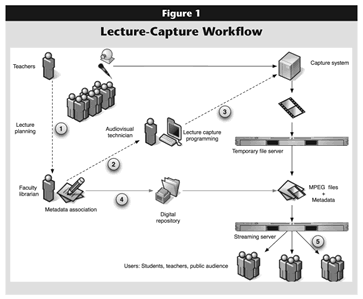
Click image for larger view.
Captured lectures are eventually recorded and stored on a temporary file server to be further processed by faculty librarians, who perform daily checks of the file server. To each new file they can associate up to 16 metadata tags (step 4), which mainly include lecture title, lecturer's name, faculty (or a school within the university), expiration date (if specified by lecturers), academic year, and so forth, as well as information related to the access policy, such as whether captured lectures should be open to the public or limited to specific end users. Having librarians in charge of the metadata guarantees the quality of information in the long term, a necessary condition for proper indexing and successful retrieval of the recorded lectures by students.
Once all this information has been provided, the file uploading operation proceeds automatically, first by storing metadata in a database synchronized with a central digital repository (currently Fedora, open-source software for managing and delivering digital content), and second by transferring the A/V files onto the central streaming server to become accessible to end users (step 5).
User Interfaces
The workflow presented in Figure 1 calls for three kinds of user interfaces: two designed for the operating staff, and one targeting the end users. For this latter audience, we implemented standard interfaces with search capabilities.9 Interfaces designated for the operating staff resulted from ad hoc developments undertaken in line with a user-centric approach borrowed from the human-computer interface (HCI) field.10 In the present context, this approach involved three steps. First, IT engineers interviewed librarians and A/V technicians to accurately understand their needs and organizational working modes. Second, visual prototypes simulating the lecture-capture processes were presented to the A/V staff. Third, final versions of the system were obtained through iterative programming by IT engineers and usability checks involving targeted users.
A/V Technicians' Interface. This interface is dedicated to programming lecture captures over periods of time typically covering a whole semester. While typically taking less than two hours to accomplish, such advance programming relieves A/V technicians from future interventions during the running semester. Programming can be scheduled on a periodic basis (daily or weekly), and lecture capture specified as live streaming or as files to be archived (or both). Streaming quality, which depends on the available bandwidth of the underlying network infrastructure, can be qualified at this stage.
The same interface also serves for special events such as conferences or when unexpected changes in a lecture occur (to location or date, for example). The second part of this interface is based on an interactive calendar that allows A/V technicians to rapidly check the programmed recordings, as shown in Figure 2. In this representation the status of the programmed lectures is codified using three colors to distinguish the recordings to come from those currently in action (ongoing recording) or already recorded (completed recording). In addition, the date, lecture hall number, name of the lecturer, start and end times of the recording, and the name of the A/V technician who did the programming are all clearly stated. To use all available features of this interface efficiently, A/V technicians attended two training sessions of two hours each.
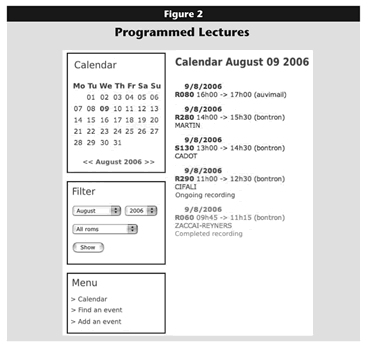
Click image for larger view.
Librarians' Interface. The design of this interface was dictated by the librarians' long practice of systematically cataloguing lectures into a database, generally (but not always) an online public access catalog (OPAC). The interface allows librarians to both upload the files on the central streaming server and specify the metadata associated with them. Librarians can sort files by the names automatically generated by the capture system (the name being a concatenation of date, time, and lecture hall number).
To speed the assignment of metadata, at the semester's beginning librarians can specify recurrent lecture information specific to a lecturer. This information is shown later by the interface (through the dynamic menu) when choosing metadata specific to the ongoing lectures. As a last step, librarians can edit the prefix of the applied unique identifier and revise the metadata before confirming the upload. As with A/V technicians, librarians had four hours of training to become proficient in file uploading and attachment of metadata to the recorded lectures.
Updating Old Tapes
The University of Geneva initiated lecture recording in the 1970s, well before digital technology was available. Until 2004, lectures were recorded on tapes and generally limited to the audio component. By 2004, about 7,000 audiotapes of durations from 60 to 90 minutes were referenced in the library catalogues. Access to these recorded lectures required a long administrative procedure, as the original tapes had first to be removed from the storehouse and then copied onto another tape before being handed over to students. This process typically took two to three days.
To offer more flexibility in accessing the lectures stored on these tapes and to maintain consistency with the new recording system, librarians submitted a questionnaire to lecturers to determine whether they wanted their lectures to be digitized. Following this survey, about 5,000 tapes were inventoried as eligible for conversion to digital form. To realize this tremendous task, which involved more than 7,000 recording hours, we contracted with a library specializing in audio books and having the capacity to process tapes at 32 times the normal speed. After a year, all 5,000 audiocassettes had been processed, converted to MP3, and fed into the central streaming server along with rudimentary metadata. The oldest tapes, which in some cases were nearly inaudible, could be partially restored through the process. Thanks to this digitization campaign, tapes are no longer used on the campus.
Lecture Capture and Recording Mechanisms
The main challenge IT engineers faced in designing the lecture-capture system was two-fold: the large number of buildings dispersed throughout the city (the university encompasses five main campuses and tens of smaller buildings), and a large diversity in the basic infrastructure found in those buildings. Complying with these constraining factors required implementation of two different architectures. In both architectures, technology was chosen according to standard A/V formats.
Architecture 1
The first architecture is adapted to modern A/V infrastructures found in the newest buildings. These infrastructures initially were designed to monitor lecture halls; to occasionally transmit a conference dispensed in one lecture hall to another, possibly located in another building; and to record conferences on audio- or videotapes. These infrastructures are characterized by a convergence of all A/V streams originating from the auditoriums to a central control room in which A/V technicians can remotely control A/V equipment with the exception of the audiotape recorders, which had to be operated by the lecturers.
The new lecture-capturing mechanism adapted to these infrastructures appears in Figure 3. It consists of a personal computer equipped with several MPEG-4 encoding boards for capturing audio and video. Each encoding board, controlled by custom-made software, has the capacity to record two A/V streams in DVD quality. These streams can also be broadcast live simultaneously, a possibility represented with dashed lines in Figure 3.
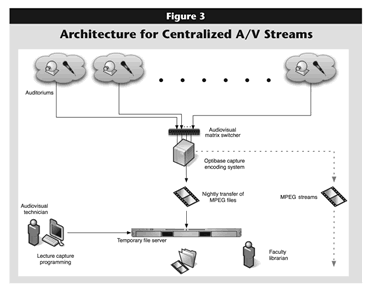
Click image for larger view.
For practical reasons (mainly cost), we installed a smaller number of encoding boards than there are lecture halls. Such optimization is a distinctive feature compared to commercial solutions, which tend to equip each lecture hall independently. Consequently, our proposed solution includes a switching matrix, also controlled by custom-made software, for establishing connections between a given A/V stream and an available encoding board (Figure 3). If none of the boards is free, A/V technicians must reexamine their scheduling. If this latter situation occurs too frequently—it has not so far—we could scale the system by adding more encoding boards.
The files resulting from daily captures are stored locally on the PC before being transferred during the night onto a temporary file server to allow further processing by librarians the following day (Figure 3). Subsequent to this last processing stage, the files are stored permanently on a secured RAID disk storage system accessible to the streaming server, and the associated metadata are synchronized with the digital repository.
Architecture 2
The second architecture suits the more general situation in which centralized A/V infrastructures are nonexistent, typically encountered on old campuses or in small buildings. This architecture has the advantage of also applying to conferences captured off-campus. Historically, this second architecture arose from an earlier attempt to replace magnetic tape recorders dispersed in the lecture halls with portable MP3 recorders. This solution, tested over a semester, failed for several reasons:
- Some lecturers were reluctant to change the technology and thus stuck to old tape recorders.
- Portable MP3 recorders were so small and discreet that often lecturers forgot to press the recording button.
- Portable MP3 recorders could not be left without taking precautions against theft. This required hefty logistics, whereby a lecturer arriving first in the lecture hall had to fetch the MP3 recorder at the building reception office, to be brought back (by lecturers or A/V technicians) at the end of the day to the faculty librarians in charge of archiving the MP3 file.
The main lesson learned from this unsuccessful experience is that except for microphones (see below concerning this component), lecturers should not be involved in the technical aspects inherent to a lecture-recording system. Consequently, we imposed a solution based on an Apple Mac Mini installed in each lecture hall and connected to the local network (Figure 4). We chose the Apple Mac Mini based on the following criteria: compactness, robustness, low-noise ventilation system, and favorable ratio between cost and processing capacity. These features made it possible to install the computers inside rack sound modules secured with a key and omnipresent in lecture halls. This way, A/V streams are directly captured on the Apple Mac Mini through USB digital converters for the sound and Firewire DV-video converters for the images.
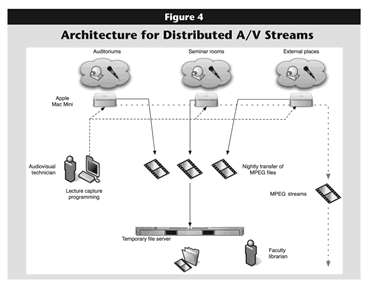
Click image for larger view.
Encoding in MPEG-4 is performed using QuickTime Pro running on each computer, while scheduling is accomplished at a distance by A/V technicians using iCal calendar software. Once programmed, the iCal application calls specific scripts that start and stop the recordings on each computer.
As in the previous architecture, locally stored files are transferred nightly onto a temporary file server for further processing by librarians the following day. Live broadcasting, indicated with dashed lines in Figure 4, is also possible with this architecture by installing QuickTime Broadcaster on each Apple Mac Mini. This results in relay of individual streams to the Internet via the central streaming server.
To further evaluate the applicability of this architecture, it was tested during an international conference hosted off-campus in a public auditorium. The main requirement for this conference was interpreting Hebrew and Arabian lecturers in French and English, with the complication that the interpreters were located on campus at the School of Translation and Interpretation.
As shown in Figure 5, A/V streams were captured and encoded using an Apple Mac Mini before being broadcast live. These streams, processed by the central streaming server on campus, were sent to two interpreters who could see the video of the lecturers' talks while translating the audio. The interpretation into French and English yielded two separate audio streams (this time without the video component) that were recorded and broadcast live again to the conference hall, where two separate computers converted them into infrared light. This light, cast throughout the conference hall, allowed attendees wearing infrared headphones tuned to French or English to follow the ongoing discussions in their respective language. In addition to live broadcast, the librarians of the School of Translation and Interpretation could catalogue the lectures captured both in native and interpreted languages for future use by students and faculty members.
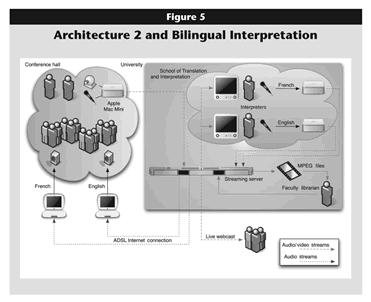
Click image for larger view.
Dissemination of Recorded Lectures
Whereas lecture capture involves—besides lecturers—A/V technicians and faculty librarians, the dissemination through live broadcast and video-on-demand (VoD) is fully automatic. Two main modes of diffusion are proposed, depending on whether viewing or downloading of the files is requested. In the former case, live broadcast and VoD are based on standard streaming protocols.11 In the latter case, access to recorded lectures is established through the "Fast-Start streaming mode," which allows loading of files on a user's PC concurrent to their playing (that is, before they are fully downloaded). This mode, currently restricted to MP3 files but suitable to other MPEG formats, is adapted whenever the documents have no intellectual property restrictions.
Benefits of the New Lecture-Capture System
We envisioned two main values in this project that we believe are relevant to academic institutions in general: the user-centric approach targeting the three groups (A/V staff, librarians, and end users—lecturers and students), and the noncommercial approach of the two architectures proposed to accommodate different building infrastructures, with different budgets.
User-Centric Approach
Assessment of the lecture-capture system was performed following six months of use by the three target groups. During this time, some improvements in the user interfaces were carried out in response to early users' suggestions.
A/V Staff. The previous system consisted of audiotape recorders that lecturers had to borrow beforehand whenever they planned to record their lectures. In some cases, an A/V technician had to be present during all the recordings. If not, they at least had to go to the lecture halls at the beginning and end of the lectures. The previous system also severely limited the number of simultaneous recordings because it depended on the availability of the A/V technicians. With the new system, the number of recordings has scaled up by a factor of three to four, to about 40 per week—a number still well below the recording system's capacity. A/V technicians particularly appreciate the flexibility of programming lecture recordings at a distance, which saves them multiple trips. That the new system largely improved the process is clear, as expressed by an A/V technician in the following terms:
Another benefit is reliability of lecture recording. Before, the audiotapes were limited to 90 minutes distributed on two sides. This led unavoidably to interruptions during most recordings due to changing the tape. Moreover, problems occurred for 10–15 percent of recordings, mainly due to improper manipulations by lecturers, resulting in lost lectures or partially recorded lectures with (frequently) the last minutes missing. As an A/V technician explained,
Reliability is now near 100 percent.
Librarians. A long tradition involved cataloging the audiotapes. This work, accomplished by librarians, is now integrated into the system workflow, ensuring the quality of metadata. In the process, librarians can supply up to 16 metadata fields, those recurrently encountered being filled once at the beginning of a semester, the rest (date, duration, comments, subtitles, and so forth) being completed as lectures are captured. One librarian observed,
Clearly, the iterative interface design approach paid off, given that the last version of the software is now handy to librarians. Another librarian concluded,
Students. Student response to the system is quite positive. It clearly gives them new opportunities in choosing curricula even if lectures overlap, which is becoming more frequent with the recent Bologna reform. As one student explained,
The new system's flexibility thus accommodates the schedules of busy students. Access to the captured lectures is also much improved by their online publication in less than 24 hours.
Quality of metadata is another factor appreciated by students, as expressed this way:
An average of 100 recorded lectures are accessed each day. This number has recently grown by 50 percent with the new option for registered students to access lectures from home (and presumably because of approaching exams). Off-campus accesses currently represent over 70 percent of all connections.
Lecturers. The system is regularly used by about 25 lecturers, producing about 40 online lectures per week. This number is likely to increase in 2007, as two buildings regrouping the faculties of Sciences and Medicine will soon start using the new system. Interviews with lecturers confirm the opinions put forward by students. Also, the students' positive responses tend to further motivate lecturers to surmount some obstacles in using technology. A lecturer wrote,
From the beginning, and based on our previous experiences (especially with the portable MP3 recorders), we knew lecturers should be insulated as much as possible from the technological aspects. This fact, documented above, is further illustrated by one lecturer who gave up lecture capture because he had to operate a microphone—which is still necessary in some lecture halls.
Noncommercial Approach
From conception to realization the new recording system took a full year to cover five main buildings and a total of 35 lecture halls. It involved an A/V engineer to specify and implement the architecture and a computer engineer to develop the Web interfaces and associated software needed to automate lecture capture and recordings. Costs for the hardware amounted to $1,800 and $900 per lecture hall for architectures 1 and 2, respectively. (See the sidebar on tools used for the system.) To these costs $800 must be added per lecture hall to take account of the central computer facilities, consisting of streaming servers and spinning storage disks (currently 6 terabytes). The basic infrastructure, such as A/V equipment in the lecture halls, network connections, and electrical and optic fiber cables in the buildings, is not considered in these costs, as in most cases these materials were already deployed.
Maintenance of the overall system mainly consists of upgrading the computers, particularly when they need repair. There are no license fees, as the system is based on open standards and custom coding. Compared to a commercial solution, the costs are quite attractive because our system remains versatile and is optimized in terms of hardware, especially in architecture 1 (centralized A/V streams).
The lecture-capture system also offers the adaptability necessary for integration into the information system and for future extensions, which remain difficult to predict (typical of technology targets in academic institutions). Furthermore, commercial products often use proprietary technologies and tend to pressure clients to purchase recurrent upgrades of their systems. This last point is particularly relevant in view of the fact that funding of this project came from a public grant limited in time, which prevents us from paying annual licenses or purchasing costly upgrades of the equipment within at least the next five years.
Conclusion
Modernization of the University of Geneva lecture-capture system, which until recently consisted of audiotapes set up in lecture halls, resulted in providing more flexibility in the overall management of the captured lectures. Currently, more than 7,000 online lectures spanning 1972 to 2007 are available. Students have already expressed their desire to download audio material, either on their PCs or portable MP3 players. A recent technical upgrade of the system to restrict access to registered students through Shibboleth,12 an authentication and authorization system implemented at the Swiss level for the Institutions of Higher Education, makes such uploading conceivable and soon to be available through RSS (Really Simple Syndication).
The implemented lecture-capture system offers the possibility of obtaining video as well as audio. For on-campus students the added-value of video is questionable, however, as recently established in a study on podcasting lectures, which determined that students favored audio.13 Nevertheless, lectures synced with PowerPoint presentations should help students study more efficiently, as previous studies have shown.14 Such upgrading will be our next focus, and while it will bring more complexity to the system, it is our firm intent not to increase the A/V staff's workload with the new technology.
Throughout our experiences as reported in this article, we gained insights into the components constituting a lecture-capture system to a degree that permits us to assert what can be automated versus what should be handled manually. Furthermore, we are more than ever convinced that we must actively adapt technology to students' needs, while leaving lecturers insulated from the technical aspects involved in lecture capture in order to concentrate on teaching.
